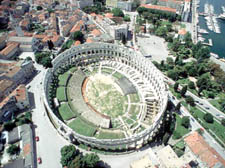|
|
 |
| |
The undiscovered treasure of Croatia
Croatian winemakers are working hard to bring their wines to international attention
FOR wine drinkers of a certain age, a walk along the wine aisles is becoming a trip down memory lane. Nostalgia rules. Wines, once loved, then considered embarrassing and banished from the shelves, have been given a makeover and are back.
The reinstated German, Blue Nun and Black Tower brands, accompanied by their French counterpart, Piat d’Or, complete with revamped, garish, eye catching labels, glare down on us from the shelves.
A drier version of Hock, a once popular, simple German wine, is again on sale at Somerfield at £2.55 a bottle but with still only nine per cent alcohol. It tastes good and makes an excellent, easy-drinking aperitif. We had turned our backs on it 30 years ago and were persuaded to drink dearer and supposedly better wines.
Other golden oldies such as Bulgarian and Hungarian wines – Bulgarian Suhindol region red wine was once the UK’s top selling red wine – are banging on the cellar door demanding entry. Only the Yugoslavian produced Laski Riesling is still missing, or so we thought.
The Innholders Hall, off Canon Street in the City of London is headquarters to a leading Livery company – the ancient order of Innkeepers – whose members along with those of 54 other companies fill the ranks of the aldermen, who comprise the government of the wealthiest square mile in the world.
In this hall – designed by Sir Christopher Wren – with its refined old-world elegance, traditional paneled walls, stucco ceilings and dangling crystal chandeliers, a small group of Croatian winemakers, sponsored by their embassy, an airline and a bank, recently presented their wines.
On arrival, we are offered a glass of white wine by Martin Puljic, Managing Director of MMM Aspect International Ltd which imports Croatian Wine into the UK.
He said: “It’s produced from the Grasvina grape, which you probably know by its Slovenian name, Laski Riesling.”
But there is much more to Croatian wine-making than the revamping of a once loved but now out of favour wine from the former Yugoslavia.
Its wine industry is comprised of two regions, the mainly red producing, coasts and islands and the predominantly white producing continental interior. Red, white, rose, sparkling, semi-sparkling, sweet, semi sweet, fortified wines and brandy are produced from hundreds of indigenous (and to us) unknown grapes, alongside the usual international grape varietals.
The majority of Croatian wines are produced by small scale wine growers rather then commercial winemakers.
Farmers tend the land, grow the grapes, harvest and then vinify them. The very best Croatian wines are often identified with the land they come from rather than the grape varietals. But it is Croatia’s indigenous grape varieties that make its wines unique. The red grape, Plavac Mali is without doubt the most important and the Dingac and Postup areas of the Peljesac peninsula region – near the ancient town of Dubrovnik – its most renowned producers.
Bogdanusa a white grape is the main component of sparkling Croatian Prosecco, Malvoisie from the Istrian peninsula and Posip from the island of Korcula are the star whites.
The Croatians are working hard on the Grasevina grape to produce a good value, easy drinking wine attractive to the mass international market. Of the international wines only the Sauvignons appear interesting, having the vegetal attributes of the New Zealand version without the awful, over-the-top gullet burning citrus aftertaste.
Croatian wines are not yet widely available in the UK but the country’s popularity as a tourist resort is on the increase and a growing number of British travellers are joining the thousands of Italians, Germans and other European who have begun to holiday again in this once war-torn region.
Travellers to the unspoilt Istria peninsula, once the favourite haunt of the Hapsburgs and other European royals will find it still retains its lavish belle epoque hotels and villas. Recently it has declared itself to be the “land of fine wine” and is taking wine tourism seriously. Its 80 wineries sell more than 50 per cent of their production direct to visitors.
Where better to drink theses original wines then in the land that grew them and in the company of the families who for generations and in the most difficult of circumstances and regardless of the scale of the disaster that has befallen them, rebuild their lives and continue to produce and sell their wine? |
 |
|
| |
 |
| |
| |
|
 |
|










